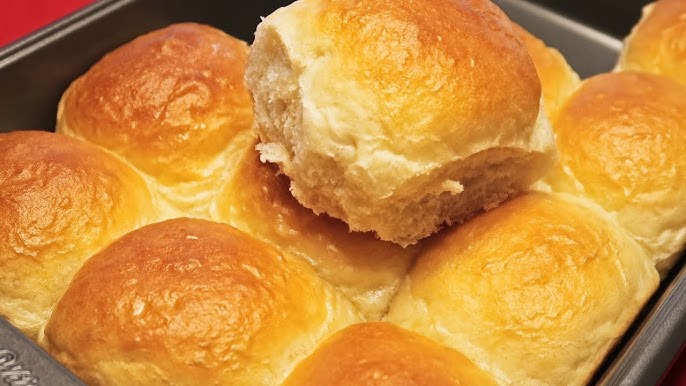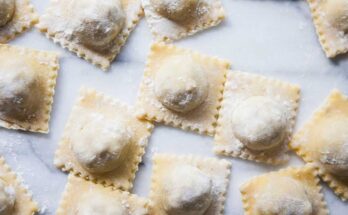Yeast Rolls Recipe: There’s nothing quite like the aroma of freshly baked yeast rolls filling your kitchen. These soft, fluffy, and buttery rolls are perfect for any occasion, from family dinners to holiday feasts. If you’ve ever wondered how to make bakery-quality yeast rolls at home, this step-by-step guide is for you.
Homemade yeast rolls not only taste better than store-bought ones, but they also allow you to control the ingredients, ensuring a healthier and more flavorful result. Follow this detailed recipe to create the perfect yeast rolls every time!
Ingredients and Tools Required
Essential Ingredients for Yeast Rolls
To get started, gather the following ingredients:
- Flour (All-Purpose or Bread Flour) – 4 cups (480g)
- Active Dry Yeast – 2 ¼ teaspoons (1 packet)
- Warm Water (110°F/43°C) – 1 cup
- Sugar – ¼ cup (50g)
- Salt – 1 teaspoon
- Butter (Melted) – ¼ cup (60g)
- Milk – ½ cup (120ml)
- Egg – 1 large
Tools Needed for Preparation
- Large Mixing Bowl
- Measuring Cups and Spoons
- Whisk or Wooden Spoon
- Stand Mixer with Dough Hook (Optional)
- Kitchen Towel or Plastic Wrap
- Baking Sheet or Pan
- Pastry Brush
How to Make Yeast Rolls – Step by Step Instructions
Step 1: Preparing the Dough
Activating the Yeast (Proofing Process)
- Begin by warming the water to about 110°F (43°C). Use a kitchen thermometer for accuracy.
- Pour the warm water into a small bowl and add the sugar. Stir until dissolved.
- Sprinkle the active dry yeast over the water and let it sit for about 5–10 minutes until it becomes frothy. This means the yeast is active.
Tip: If the mixture doesn’t foam, the yeast may be expired. Start again with fresh yeast.
Mixing the Dough Properly
- In a large mixing bowl, combine the flour and salt.
- Add the milk, melted butter, and egg into the yeast mixture and whisk until smooth.
- Gradually add the wet mixture to the dry ingredients, stirring constantly until a sticky dough forms.
Tip: Avoid adding too much flour; the dough should be slightly sticky but manageable.
Step 2: Kneading the Dough
Why Kneading Is Crucial for Fluffy Rolls
Kneading helps develop gluten, which is essential for the dough’s structure and elasticity. Proper kneading ensures your rolls rise well and have a soft texture.
Techniques for Perfect Kneading
- Lightly flour your work surface and transfer the dough onto it.
- Use the heel of your hands to push the dough away, then fold it back toward you.
- Rotate and repeat this motion for 8–10 minutes until the dough is smooth and elastic.
Tip: You can also knead the dough in a stand mixer with a dough hook for 5–6 minutes on medium speed.
Step 3: First Rise (Proofing the Dough)
Setting the Dough for Rising
- Place the kneaded dough into a lightly greased bowl.
- Cover it with a damp kitchen towel or plastic wrap.
- Let it rise in a warm, draft-free place for about 1–1.5 hours, or until it doubles in size.
Tip: An oven with the light on can provide a warm environment for rising.
Tips to Ensure Proper Dough Rising
- Avoid placing the dough in overly hot areas, as this can kill the yeast.
- Check after 1 hour; if the dough hasn’t doubled, allow it to rise longer.
Step 4: Shaping the Rolls
Dividing the Dough into Portions
- Punch down the dough to release excess air and transfer it to a floured surface.
- Use a knife or dough scraper to divide it into equal portions (usually 16–20 pieces).
Tip: Weigh each portion for uniform-sized rolls if desired.
Shaping Techniques for Uniform Rolls
- Roll each piece into a ball by pulling the edges underneath and pinching them at the bottom.
- Place the rolls on a greased baking sheet, leaving some space between them for expansion.
Tip: For a decorative look, braid or twist some rolls.
Step 5: Second Rise (Final Proofing)
Preparing Rolls for Baking
- Cover the rolls lightly with plastic wrap or a clean kitchen towel.
- Let them rise again for 30–45 minutes until they puff up.
How Long to Let Them Rise Again
Ensure the rolls double in size during this rise. This step ensures they bake evenly and have a soft interior.
Tip: Don’t skip this step, as it determines the final texture of your rolls.
Step 6: Baking the Rolls
Setting the Oven Temperature
- Preheat your oven to 375°F (190°C) about 10–15 minutes before baking.
- Place an oven rack in the center position for even heat distribution.
Tip: Always preheat the oven to ensure consistent results. Cold ovens can cause uneven baking and poor texture.
Baking Time and Techniques for Golden Crust
- Once the oven is preheated, place the baking sheet with the rolls inside.
- Bake for 12–15 minutes or until the tops are golden brown.
- Rotate the pan halfway through baking if your oven has uneven heat zones.
Tip: Lightly tap the rolls—if they sound hollow, they are done.
Step 7: Finishing Touches
Adding Butter Glaze for Shine and Flavor
- As soon as the rolls come out of the oven, brush the tops with melted butter.
- This not only gives them a glossy appearance but also adds richness and flavor.
Tip: For a sweeter variation, brush them with honey butter instead.
Optional Toppings for Extra Flavor
- Sprinkle coarse sea salt for a savory touch.
- Add garlic butter or herb seasoning for enhanced flavor.
- Dust with cinnamon sugar for a sweet version.
Tip: Experiment with toppings to match your meal or preference.
Common Mistakes to Avoid
Overproofing or Underproofing Dough
- Overproofing: Dough rises too much and collapses, leading to dense rolls. Avoid leaving dough for excessive periods.
- Underproofing: Dough doesn’t rise enough, resulting in hard rolls. Always check for volume doubling during each rise.
Tip: Use the poke test—gently press your finger into the dough. If it springs back slowly, it’s ready.
Baking at the Wrong Temperature
- Too hot: Rolls may burn on the outside but stay raw inside.
- Too low: Rolls may remain pale and take longer to cook, leading to dryness.
Tip: Use an oven thermometer to verify temperature accuracy.
Storage and Reheating Tips
How to Store Leftover Rolls
- Let the rolls cool completely before storing.
- Place them in an airtight container or resealable plastic bag.
- Store at room temperature for up to 3 days.
Tip: Avoid refrigerating rolls as it can make them stale faster.
Best Methods for Reheating
- Oven Method: Preheat oven to 350°F (175°C), wrap rolls in foil, and warm for 5–10 minutes.
- Microwave Method: Cover with a damp paper towel and heat in 15-second intervals until warm.
Tip: Adding a small bowl of water in the microwave keeps rolls from drying out.
FAQs about Yeast Rolls Recipe
1. What ingredients are needed for yeast rolls?
To make yeast rolls, you typically need all-purpose flour, active dry yeast, milk, sugar, butter, eggs, and salt. Some variations might include additional ingredients like honey or herbs for flavor.
2. How long does it take to make yeast rolls?
The total time to make yeast rolls, including preparation and cooking, is approximately 2 to 3 hours. This includes time for the dough to rise, which is crucial for developing the right texture.
3. Can I make yeast rolls ahead of time?
Yes, yeast rolls can be made ahead of time. You can prepare the dough and let it undergo the first rise, then shape the rolls and refrigerate overnight. Allow them to come to room temperature and complete the second rise before baking.
4. How do I know if the yeast is still active?
To test yeast’s activity, dissolve it in warm water with a pinch of sugar; it should start to form bubbles and froth within about 10 minutes. If it doesn’t, the yeast may be inactive, and new yeast should be used.
5. What are some common problems when making yeast rolls?
Common issues include dough not rising due to old yeast, rolls being too dense from insufficient kneading, or the texture being too tough if over-kneaded. Make sure your yeast is fresh and follow the kneading instructions carefully.
6. Can yeast rolls be frozen?
Yes, yeast rolls can be frozen either before or after baking. To freeze before baking, place shaped rolls on a baking sheet to freeze individually, then transfer to a freezer bag. Thaw overnight in the refrigerator, then let rise and bake as usual. For already baked rolls, cool them completely, wrap tightly, and freeze. Reheat in the oven to serve.
Conclusion
Congratulations! You’ve now mastered the art of baking homemade yeast rolls. From activating the yeast to shaping and baking, each step plays a vital role in achieving fluffy, golden-brown rolls that everyone will love.
Whether you’re serving them as a side for dinner, using them for sandwiches, or simply enjoying them with butter and jam, these versatile rolls are sure to impress. Don’t be afraid to experiment with different toppings and fillings to make them your own.
So go ahead—gather your ingredients and start baking today! Nothing beats the satisfaction of homemade bread fresh out of the oven.



